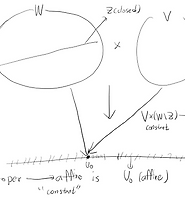아무 블로그
Selmer complex 1 본문
$\newcommand{\Z}{\mathbb{Z}} \newcommand{\Q}{\mathbb{Q}} \newcommand{\R}{\mathbb{R}}
\newcommand{\C}{\mathbb{C}} \newcommand{\Spec}{\mathrm{Spec}\,} \newcommand{\O}{\mathcal{O}} \newcommand{\bb}[1]{\mathbb{#1}} \newcommand{\d}{\mathrm{d}} \newcommand{\F}{\mathbb{F}}
\newcommand{\N}{\mathbb{N}} \newcommand{\P}{\mathbb{P}} \newcommand{\m}{\mathfrak{m}}
\newcommand{\GL}{\mathrm{GL}}
\newcommand{\et}{\mathsf{\acute{e}t}} \newcommand{\lara}[1]{\langle #1 \rangle}
\newcommand{\leris}[1]{\left(#1\right)}
\newcommand{\lerim}[1]{\left\{#1\right\}}
\newcommand{\leril}[1]{\left[#1\right]} \newcommand{\Hom}{\mathrm{Hom}} \newcommand{\Tor}{\mathrm{Tor}}
\newcommand{\Ext}{\mathrm{Ext}}
\newcommand{\holim}{\mathrm{holim}}
\newcommand{\sep}{\mathrm{sep}}
\newcommand{\Gal}{\mathrm{Gal}}
\newcommand{\Mod}{\mathsf{Mod}}
\newcommand{\coker}{\mathrm{coker}}
\newcommand{\Im}{\mathrm{Im}}
\newcommand{\Ker}{\mathrm{Ker}}
\newcommand{\unr}{\mathrm{unr}}
\newcommand{\End}{\mathrm{End}}
\newcommand{\op}{\mathrm{op}}
\newcommand{\Sh}{\mathsf{Sh}}
\newcommand{\Sch}{\mathsf{Sch}}
\newcommand{\Alg}{\mathsf{Alg}}
\newcommand{\p}{\mathfrak{p}}$
http://www.numdam.org/issue/AST_2006__310__R1_0.pdf
무슨 니체가 빙의했나 Nekovar 왈 Selmer group은 죽었다는데 자기가 만든 Selmer complex가 얼마나 대단하길래 Selmer group을 죽이는지 보자고요. Introduction만 볼께요.
0.0. Big Galois representation
여기에선 "big Galois representation"
$$ \rho:G\longrightarrow \mathrm{Aut}_R(T)$$
를 보겠대요. 여기서
(i) $G$는 적당-한 Galois group이고
(ii) $R$은 complete local noetherian ring with a finite residue field of char. $p$고(그럼 경우의 수는 꼴랑 두가지밖에 없겠지요)
(iii) $T$는 $R$-module of finite type이고
(iv) $\rho$는 pro-finite group의 continuous homomorphism이라네요.
그렇다면 이런 Galois representation이 원래는 some good cohomology란 점에서 duality가 있을 수 있고 이런 cohomology를 간단하게 만드는 Iwasawa theory가 있을 수도 있고 Cassels-Tate pairing이 있을 수도 있고 generalized height pairing이 있을 수 있대요.
0.1 Examples
0.1.0.
흔한 예시로 $K$가 char.이 $p$가 아닌 어느 field고 모든 $K$-scheme $X\to \Spec K$에 대해서 $\overline{X}:=X\otimes_K K^{\sep}$라고 두자고요. 그러면 separated $K$-scheme들의 projective system $X_{\infty}=(X_{\alpha})_{\alpha\in I}$가 있을 수 있어요. 여기서 $X_{\beta}\to X_{\alpha}$는 당연히 finite가 되도록 두어야 대충 생각해도 cohomology 계산이 가능해질 거고 그럼
$$ H^i(X_{\infty}):=\lim_{\substack{\longleftarrow \\ \alpha}}H^i_{\et}(\overline{X}_{\alpha},\Z_p)=\lim_{\substack{\longleftarrow \\ \alpha}}\lim_{\substack{\longleftarrow \\ \n}}H^i_{\et}(\overline{X}_{\alpha},\Z/p^n)$$
으로 정의하겠대요. 여기서 trace map으로 transition map을 정의하고요. 그럼 이건 $G_K=\Gal(K^{\sep}/K)$-representation이 된다는 건 당연하고 덤으로 $X_{\infty}$에 있는 endomorphism도 있대요. 그니까 $H^i(X_{\infty})$는 in practice 너무 "커요". Leray spectral sequence를 생각하면 $X_{\alpha}=X_{\beta}$가 아닌 $(\alpha,\beta)$ 쌍이 무한개 있으면 저건 무조건 $\Z_p$ 위에서 rank가 무한대가 될 테니까 말이죠. 그럼에도 이걸 정의하는 것은 이것이 그냥 cohomology보다 계산이 훨씬 쉽고 덤으로 이것의 decomposition에서 무언가가 나오기에 그럴 거예요. 사실 전 저 cohomology가 먼저고 우리가 보통 생각하던 cohomology들은 Leray spectral sequence로 정의해야 한다고 말하고 싶어요
0.1.1. Iwasawa theory
$K_{\infty}/K$가 Galois extension with $\Gamma=\Gal(K_{\infty}/K)\cong \Z^r_p$라고 해봐요. 그리고 $K_{\infty}=\bigcup K_{\alpha}$라고 하고 separable $K$-scheme $X\to \Spec K$를 잡고 $X_{\alpha}:=X\otimes_K K_{\alpha}$라고 정의한다면
$$ H^i(X_{\infty})\overset{\cong}{\longrightarrow} H^i_{\et}(\overline{X},\Z_p)\otimes_{\Z_p}\Lambda$$
란 isomorphism을 만들 수 있어요. 여기서 $\Lambda=\Z_p[[\Gamma]]\cong \Z_p[[X_1,\cdots,X_r]]$이고요. 이것의 증명은 $X_j\to X_i$의 Galois group이 $\Gal(K_j/K_i)$니까 Leray spectral sequence를 생각하면
$$H^i_{\et}(\overline{X}_{\alpha},\Z_p)=H^i_{\et}(\overline{X},\Z_p\otimes_{\Z_p} \Z_p[\Gal(K_{\alpha}/K)])=H^i_{\et}(\overline{X},\Z_p)\otimes_{\Z_p}\Z_p[\Gal(K_{\alpha}/K)]$$
가 되어서 그렇겠지요??
0.1.2. Hida theory
Hida theory란 건 거창해보이는 이름이지만 그저 Iwasawa theory for modular form 그 자체에 불과해요. $N\ge 1$이 an integer not divisible by $p$라고 할께요. 그러면 $X_{\infty}$가 projective system of modular curves
$$ \cdots \longrightarrow X_1(Np^{r+1})\longrightarrow X_1(Np^r)\longrightarrow \cdots \longrightarrow X_1(Np)$$
over $K=\Q$를 생각하면 $X_{\infty}$는 정말로 많은 endomorphism이 있대요. Hecke correspondence라고 불리는 그것이죠. 이런 의미에서 저는 Iwasawa theory는 사실 $p$로 곱하기의 원래 모습이라고 생각해요
쨌든, 위에서 말했듯 $H^1(X_{\infty})$는 너무 커요. 하지만 $H^1(X_{\infty})^{\mathrm{ord}}$로 cohomology를 줄일 수 있고, 이것은 $T(p)$가 invertible이 되도록 만드는 애들이고, 이건 projective limit of the ordinary parts of the $\Z_p$-Hecke algebras acting on $S_2(\Gamma_1(Np^r))$로 정의되는 ordinary Hecke algebra $\mathfrak{h}^{\mathrm{ord}}$ 위에서 finite type이 된다네요. $\mathfrak{h}^{\mathrm{ord}}$는 $\Gamma=\Z_p[[\Gamma]]$ 위에서($\Gamma$가 $X_{\infty}$에 diamond operator로 act할 때) finite and free가 되고 maximal ideal $\mathfrak{m}\subseteq \mathfrak{h}^{\mathrm{ord}}$를 잡는다면 $T=H^1(X_{\infty})^{\mathrm{ord}}_{\m}$은 $G_{\Q}$의 big Galois representation over $R=\mathfrak{h}^{\mathrm{ord}}_{\m}$이 되겠지요.
0.1.3.
물론 0.1.1하고 0.1.2를 같이 하는 것도 가능하고요 diagram 커지므로 생략~~ 근데 rational model of modular curve 하려면 꼭 해야 하는 과정이긴 해요
0.2. Selmer groups
$K$가 number field고 projective system $X_{\infty}$가 good reduction outside a finite set $S$ of places of $K$ containing all places above $p$를 가진다고 해봐요. 그럼 $H^i(X_{\infty})$는 $K_S/K$가 $S$ 바깥에서 unramified인 maximal extension이라면 $G_{K,S}:=\Gal(K_S/K)$-representation이 되지요.
더 일반적으로, $T$라는 $G_{K,S}$의 representation이 주어진다면 둘이 흥미롭대요.
(i) Galois cohoology group $H^i_{\mathrm{cont}}(G_{K,S},T)$
(ii) Selmer groups $\mathrm{Sel}(G_{K,S},T)\subseteq H^1_{\mathrm{cont}}(G_{K,S},T)$
두번째는 local conditions in $H^1_{\mathrm{cont}}(G_v,T)$로 정의되고요.
이 생각을 처음 한 게 지금도 수학을 하고 있는 Greenberg인데 Iwasawa main conjecture가 어따구로(...) 생겼는지를 생각한다면 이걸 일반적인 $p$-adic representation에 대해서 일반화할 수 있다고 생각하는 것은 누구나 가능할 거예요. 그니까 big Selmer group의 characteristic ideal과 $p$-adic L-function을 연결할 수 있는가?? 물론 그 $p$-adic L-function이 뭘로 정의되어야 하는지 모르지만 말이에요. 전 사실 Iwasawa main conjecture가 왜 있는지를 생각한다면 아예 이걸로 $p$-adic L-function을 정의해야 한다고 생각해요
big Galois representation을 설명할 건데 이건 family of usual Galois representations $\rho_{\lambda}:G_{K,S}\to \GL_n(\Z_p)$라네요. 여기서 $\lambda$는 $L$-function에 집어넣을 special value가 될 거고요.
0.3. Big vs. finite Galois representation
모든 big Galois representation $\rho:G\to \mathrm{Aut}_R(T)$는 projective limit of Galois reprsentations $\rho_n:G\to \mathrm{Aut}_R(T/\m^n T)$ with finite targers로 표현할 수 있어요. 따라서 $\rho_n$을 아는 걸로 $\rho$를 안다는데 영 찝찝하네요 $R$의 setting 생각하면 아예 모든 $\rho$가 $\rho_n$로 정의되어야 하니까 그렇다고 말하면 될 텐데
예를 들면, representation $\rho_K\to \mathrm{Aut}_R(T)$ of $G_K=\Gal(K^{\mathrm{sep}}/K)$ for a local field $K$ of char. not $p$를 생각하자고요. 그러면 Pontryagin dual functor
$$ D(-)=\Hom_{\mathrm{cont}}(-,\R/\Z)$$
를 생각할 수 있고, Tate's local duality는 그럼 $H^i(G_K,T/\m^nT)$하고 $H^{2-i}(G_K,D(T/\m^n T))$ 사이의 pairing을 말하지요. projective limit를 씌우면 이는 곧바로 $H^i(G_K,T)$하고 $H^{2-i}(G_K,D(T))$ 사이의 pairing을 말하게 되겠지요??
0.4. Compact vs. discrete modules
위의 시각으로 보면, Tate's local duality는 Pontryagin dual(곧 $0$-dimensional Serre duality!!)의 Galois representation version이란 느낌이 팍팍 드시나요?? 그럼 Pontryagin dual이 이런 representation들에 대해서 어떻게 행동하는지 보는 것도 꽤 재미있을 것 같아요 이것도 Greenberg가 첨 했대요
classical case인 $R=\Z_p$ 먼저 볼께요. 그리고 $\rho:G\to \mathrm{Aut}_{\Z_p}(T)$가 있다고 해봐요. 여기서 $T$는 free rank over $\Z_p$고요. 그럼 다음 셋을 정의할 수 있어요.
$$\begin{align}A&=T\otimes_{\Z_p}\Q_p/\Z_p\\T&=\Hom_{\Z_p}(T,\Z_p)=D(A) \\A^*&=T^*\otimes_{\Z_p}\Q_p/\Z_p\end{align}$$
그리고 $\Phi:T\mapsto A, \mathcal{D}:T\mapsto T^*, D:T\mapsto A^*$라고 한다면 이들의 관계를 알 수 있을 거예요.
그럼 general $R$에 대해서 어떻게 construct할까요. 특히 $T$가 torsion이 있을 땐 $T\otimes_{\Z_p}\Q_p/\Z_p$는 모든 torsion $T_{\mathrm{tor}}\cong \Tor^{\Z_p}_1(T,\Q_p/\Z_p)$를 날려보리지요. 따라서 다음을 생각하고 싶대요
$$ A:=T\otimes^L_{\Z_p}\Q_p/\Z_p$$
그러면 날아가는 정보따윈 없어요!! 이를 concrete하게 나타내보면 $(\Z_p\to \Q_p)$란 complex로 $\Q_p/\Z_p$의 flat resolution을 잡으면 저 complex는 $(T\to T\otimes_{\Z_p}\Q_p)$쯤 되겠지요.(각각 $-1,0$의 위치에 있음)
그럼 일반적인 $R$에 대해선 그 maximal ideal을 $\m$이라고 하고 regular system $x_1,\cdots,x_d\in \m$을 생각하면 다음 Cech complex of injective hull of quotient field of $R/\m$ as $R$-module이 될
$$ C^{\bullet}=C^{\bullet}(R,(x_i))=\left(R\longrightarrow \bigoplus_i R_{x_i}\longrightarrow \bigoplus_{i<j}R_{x_ix_j}\longrightarrow \cdots \longrightarrow R_{x_1\cdots x_d}\right)$$
를 생각하고 그럼 $A=\Phi(T):=T\otimes^L_R C^{\bullet}=T\otimes_R C^{\bullet}$을 정의할 수 있지요. 그리고 Pontryagin dual은 보통 하던 것처럼 $R/\m$의 injective hull을 $I$라고 하면 $D(M)=\Hom_R(M,I)$로 정의할 수 있어요.
그렇다면 $D\circ \Phi(-)\cong R\Hom_R(-,D(C^{\bullet}))$은 adjoint property고 그럼 $D(C^{\bullet})$은 보통 "dualizing sheaf"라고 부리는 애고 얘를 $\omega$라고 쓴다면 $\mathcal{D}=R\Hom_R(-,\omega)$라고 쓸 수 있게 돼요. 그리고 adjoint property로 spectral sequence를 하나 만들면
$$ E^{ij}_2=\Ext^i_R(D(H^j(A)),\omega)=\Ext^i_R(H^{-j}(T^*),\omega)\implies H^{i+j}(\mathcal{D}(T^*))=H^{i+j}(T)$$
란 spectral sequence를 만들 수 있지요. 여기까지 할께요
'수학 > 정수론' 카테고리의 다른 글
| Abelian variety 5 (0) | 2020.04.29 |
|---|---|
| Abelian variety 4 (0) | 2020.04.29 |
| Abelian variety 3 (0) | 2020.04.29 |
| Abelian variety 2 (0) | 2020.04.29 |
| Abelian variety 1 (0) | 2020.04.29 |

